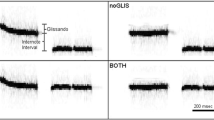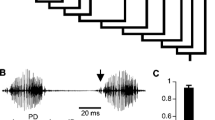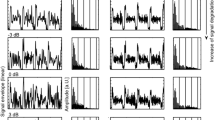Abstract
Is discrimination of the envelope of an acoustic signal based on spectral or temporal computations? To investigate this question for the cricket Gryllus bimaculatus, pattern envelopes were constructed by the addition of several sine waves and modified by systematic phase changes. The phonotactic response of female crickets towards such sinusoidal but also rectangular pulse patterns was quantified on a locomotion compensator. Envelope patterns that exhibited a modulation frequency of 25 Hz as the dominant frequency were attractive and although changes of phase modified the temporal pattern, the values of attractiveness remained unaffected. Removal of the 25-Hz component reduced the phonotactic scores. Patterns in which other frequency components exhibited a larger amplitude than the 25-Hz component were less attractive. However, the combination of an unattractive pulse period with the attractive modulation frequency of 25 Hz in a pattern revealed that such stimuli were unattractive despite the presence of the 25-Hz component. A comparison of the attractiveness of all patterns revealed that female crickets evaluated the duration of pulse period over a wide range of duty cycles. The combined evidence showed that pattern envelopes were processed in the time- and not in the spectral domain.








Similar content being viewed by others
References
Barber CB, Dobkin DP, Huhdanpaa HT (1996) The Quickhull algorithm for convex hulls. ACM Trans Math Softw 22:469–483
Benda J, Hennig RM (2007) Spike-frequency adaptation generates intensity invariance in a primary auditory interneuron. J Comput Neurosci 24:113–136
Bush SL, Schul J (2006) Pulse-rate recognition in an insect: evidence of a role for oscillatory neurons. J Comp Physiol A 192:113–121
de Cheveigne A (2006) Pitch perception models. In: Plack CJ, Oxenham AJ, Fay RR, Popper AN (eds) Pitch—neural coding and perception. Springer, New York, pp 167–233
Deily JA, Schul J (2009) Seletive phonotaxis in Neoconocephalus nebrascensis (Orthoptera: Tettigoniidae): call recognition at two temporal scales. J Comp Physiol A 195:31–37
Doherty JA (1985) Trade-off phenomena in calling song recognition and phonotaxis in the cricket, Gryllus bimaculatus (Orthoptera, Gryllidae). J Comp Physiol 156:787–801
Friedel P, Bürck M, van Hemmen JL (2007) Neuronal identification of acoustic signal periodicity. Biol Cybern 97:247–260
Gerhardt HC, Huber F (2002) Acoustic communication in insects and anurans. University of Chicago Press, Chicago
Grothe B, Covey E, Casseday JH (2001) Medial superior olive of the big brown bat: neuronal responses to pure tones, amplitude modulations, and pulse trains. J Neurophysiol 86:2219–2230
Hartmann WM (1998) Signals, sound and sensation. Springer, Berlin
Hennig RM (2003) Acoustic feature extraction by cross-correlation in crickets? J Comp Physiol A 189:589–598
Hennig RM, Weber T (1997) Filtering of temporal parameters of the calling song by cricket females of two closely related species: a behavioral analysis. J Comp Physiol A180:621–630
Hennig RM, Franz A, Stumpner A (2004) Auditory processing in insects. Micr Res Techn 63:351–374
Huber F, Moore TEM, Loher W (1989) Cricket behavior and neurobiology. Cornell University Press, Ithaca, NY
Imaizumi K, Pollack GS (1999) Neural coding of sound frequency by cricket auditory receptors. J Neurosci 19:1508–1516
Imaizumi K, Pollack GS (2001) Neural representation of sound amplitude by functionally different auditory receptors in crickets. J Acoust Soc Am 109:1247–1260
Joris PX, Schreiner CE, Rees A (2004) Neural processing of amplitude-modulated sounds. Physiol Rev 84:541–577
Konishi M (1990) Similar algorithms in different sensory systems and animals. Cold Spring Harb Symp Quant Biol 1990(55):575–584
Kostarakos K, Hartbauer M, Römer H (2008) Matched filters, mate choice and the evolution of sexually selected traits. PLoS ONE 3(8):e3005. doi:10.1371/journal.pone.0003005
Krahe R, Ronacher B (1993) Long rise times of sound pulses in grasshopper songs improve the directionality cues received by the CNS from the auditory receptors. J Comp Physiol A 173:425–443
Krahe R, Budinger E, Ronacher B (2002) Coding of a sexually dimorphic song feature by auditory interneurons of grasshoppers: the role of leading inhibition. J Comp Physiol A 187:977–985
Langner G (1992) Periodicity coding in the auditory system. Hear Res 60:115–142
Lorenz K (1943) Die angeborenen Formen möglicher Erfahrung. Z Tierpsychol 5:235–409
Marr D (1982) Vision. W. H. Freeman, San Francisco
Michelsen A, Larsen ON, Surlykke A (1985) Auditory processing of temporal cues in insect songs: frequency or time domain. In: Michelsen A (ed) Time resolution in auditory systems. Springer, Berlin
Nabatiyan A, Poulet JFA, de Polavieja GG, Hedwig B (2003) Temporal pattern recognition based on instantaneous spike rate coding in a simple auditory system. J Neurophysiol 90:2484–2493
Otte D (1992) The evolution of cricket songs. J Orthop Res 1:25–49
Plack CJ, Oxenham AJ, Fay RR, Popper AN (2006) Pitch—neural coding and perception. Springer, New York
Pollack GS, El-Feghaly E (1993) Calling song recognition in the cricket Teleogryllus oceanicus: comparison of the effects of stimulus intensity and sound spectrum on the selectivity for temporal pattern. J Comp Physiol A 171:759–765
Pollack GS, Hoy RR (1979) Temporal pattern as a cue for species-specific calling song recognition in crickets. Science 204:429–432
Poulet JFA, Hedwig B (2005) Auditory orientation in crickets: pattern recognition controls reactive steering. PNAS 102:15665–15669
Prinz P, Ronacher B (2002) Temporal modulation transfer functions in auditory receptor fibres of the locust (Locusta migratoria L.). J Comp Physiol A188:577–587
Römer H, Lewald J (1992) High-frequency sound transmission in natural habitats: implications for the evolution of insect acoustic communication. Behav Ecol Sociobiol 29:437–444
Ronacher B, Hoffmann C (2003) Influence of amplitude modulated noise on the recognition of communication signals in the grasshopper Chorthippus biguttulus. J Comp Physiol A 189:419–425
Sabourin P, Gottlieb H, Pollack GS (2008) Carrier-dependent temporal processing in an auditory interneuron. J Acoust Soc Am 123:2910–2917
Schildberger K (1984) Temporal selectivity of identified auditory neurons in the cricket brain. J Comp Physiol A 155:171–185
Schmidt A, Ronacher B, Hennig RM (2007) The role of frequency, phase and time for processing amplitude modulated signals by grasshoppers. J Comp Physiol A 194:221–233
Schüch W, Barth FG (1990) Vibratory communication in a spider: female responses to synthetic male vibrations. J Comp Physiol A 166:817–826
Schul J (1998) Song recognition by temporal cues in a group of closely related bushcricket species (genus Tettigonia). J Comp Physiol A 183:401–410
Schul J, Bush S (2002) Non-parallel coevolution of sender and receiver in the acoustic communication system of treefrogs. Proc R Soc Lond B 269:1847–1852
Shannon RV, Zeng FG, Kamath V, Wygonski J, Ekelid M (1995) Speech recognition with primary temporal cues. Science 270(5234):303–304
Thorson J, Weber T, Huber F (1982) Auditory behaviour of the cricket. II. Simplicity of calling-song recognition in Gryllus, and anomalous phonotaxis at abnormal carrier frequencies. J Comp Physiol 146:361–378
Tinbergen N (1951) The study of instinct. Oxford University Press, Oxford
Tschuch G (1977) Der Einfluß synthetischer Gesänge auf die Weibchen von Gryllus bimaculatus De Geer (Teil 2). Zool Jb Physiol 81:360–372
Verburgt L, Fergusen JWH, Weber T (2007) Phonotactic response of female crickets on the Kramer treadmill: methodology, sensory and behavioural implications. J Comp Physiol A 194:79–96
von Helversen D, von Helversen O (1998) Acoustic pattern recognition in a grasshopper: processing in the time or frequency domain? Biol Cybern 79:467–476
Webb B, Wessnitzer J, Bush S, Schul J, Buchli J, Ijspeert A (2007) Resonant neurons and bushcricket behaviour. J Comp Physiol A 193:285–288
Weber T, Thorson J (1989) Phonotactic behavior of walking crickets. In: Huber F, Moore TE, Loher W (eds) Cricket behavior and neurobiology. Cornell University Press, Ithaca, NY, pp 310–339
Weber T, Thorson J, Huber F (1981) Auditory behaviour of the cricket. I. Dynamics of compensated walking and discrimination paradigms on the Kramer treadmill. J Comp Physiol 141:215–232
Wendler G (1990) Pattern recognition and localization in cricket phonotaxis. In: Gribakin FG, Wiese K, Popov AV (eds) Sensory systems and communication in Arthropods. Birkhäuser, Basel, pp 387–394
Acknowledgments
Anne Hanschke, Simone Götze, Viktor Naumov and Matti Rothbart kept the crickets running on the Kramer-Kugel. Jan Benda, Jan Clemens, Jannis Hildebrandt and Bernhard Ronacher helped with numerous discussions and comments and their insights to signal processing. The performed experiments comply with the “Principles of animal care”, publication No. 86-23, revised 1985 of the National Institute of Health, and also with the current laws of Germany. Funded by the DFG (he2812/3-1).
Author information
Authors and Affiliations
Corresponding author
Rights and permissions
About this article
Cite this article
Hennig, R.M. Walking in Fourier’s space: algorithms for the computation of periodicities in song patterns by the cricket Gryllus bimaculatus . J Comp Physiol A 195, 971–987 (2009). https://doi.org/10.1007/s00359-009-0473-0
Received:
Revised:
Accepted:
Published:
Issue Date:
DOI: https://doi.org/10.1007/s00359-009-0473-0




